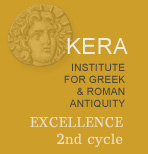Main Site . Other insciptions from the main site of Boubon
35. Honorary inscription for an unknown benefactor
![]()
5 |
-------------------- πόλεως. Ἡ πατρὶς βουλῆς [καὶ δή]– μου δόγματι τὸν̣ ε̣[ὐερ]– γέτην vac λέοντι vac |
... of the city. The fatherland, by decree of the council and the people, (honored) the benefactor with a lion.
Rectangular block, found south of the agora and documented by Heberdey in 1895. Not recovered by Bean and Schindler. The stone was rough at the top and bottom, and even at the sides, and thus probably belonged to a structure built of at least three stones in vertical order, maybe a base.
Height: 53 cm; length: 53 cm; depth: 50 cm; letters: 2.5 cm.
Schindler 1972, no. 7 (pl. 1.4: Heberdey's drawing); Milner 1998, p. 2, no. 1.20; BullÉp 1973, no. 454.
L. 1 : According to Heberdey's drawing, πόλεως was engraved very close to the upper rim of the stone, too close to have been the beginning of the inscription. This word, then, was the last word of a text section which had been engraved on the super-imposed block, and not, as one might otherwise suppose, an elliptic phrase meaning (monument raised by) the city.
L. 1-4 : Robert (in BullÉp, cf. Schindler) interprets ΛΕΟΝΤΙ as the vocative Λεόντι of the name Λεόντις, a pet name for Λεόντιος, and as part of a declamation together with the imperative [εὐτύχι] (sometimes attested instead of [εὐτύχει]): Leon prosper!. This reading presents some difficulties. Λεόντις is a rarely attested form. Further, if another word such as εὐτύχει were to be supplied after the spatium, the arrangement of the text would appear careless, with this last line of text inscribed on the right part of the stone instead of the middle (as in ll. 1 and 4), when in fact this inscription was of high quality, both in respect of the letter forms and of the text arrangement (Schindler, op. cit.: Der Stil der Inschrift ist sorgfältig, wie Formen und Verteilung der Buchstaben zeigen). ΛΕΟΝΤΙ must, therefore, have been the final word of this document, engraved in the center of the line, as Heberdey and Schindler assumed. The word need not have been a name, however. The identity of the benefactor to whom this monument was raised was undoubtedly revealed in the upper part of the inscription, so that the last four lines need not have repeated his name. It seems more likely that ΛΕΟΝΤΙ is to be read as λέοντι, the dative of λέων, lion. The monument to which this inscription belonged must have included a lion sarcophagus like those common in the region (cf. Robert 1937, pp. 391-398). Though the syntax may seem awkward at first sight, this reading should be preferred as one already attested in Boubon. In inscription no. 58, a man "raises himself (ἑαυτόν, acc.) a lion (acc.) and his wife (acc.) a statue (dat.)". The strange double accusative construction is attested elsewhere, particularly in Lycaonia: Δημήτριος Πασίωνος ζῶν καί φρονῶν ἀνέστησεν ἑαυτόν λέοντα...; Λούκιος ἀνέστησεν Τήλεφον καὶ Μάρκον καὶ Σέξτο[ν καὶ] ἑαυτὸν ἀετόν... (Robert, op. cit., p. 394); Γουνδιανὴ Διοκλέου̣ς̣ ἀνέθηκε[ν] λέοντα τὸν ἄνδρα αὐτῆς Νησιν Ἰνδακου κὲ τὸν υἱὸν αὐτῆς Λεόντιον, μ(νήμης) χ(άριν) (MAMA 8 308). In Cibyra there is a marked preference for the construction ἀνέστησεν + acc. (with a single accusative); cf. IK Kibyra I 192; 224; 325; 326; 368; 398; Naour 1976, p. 134, no. 29. Such constructions with a single or double accusative, if they are not simply a dialectical peculiarity, may mean that the monument included a representation of the deceased; see Corsten's commentary in IK Kibyra I, p. 192; cf. 203, on the accusative without ἀνέστησεν. The dative (in this case λέοντι) seems to be in better agreement with classical grammar, for it might be understood as dativus instrumentalis; the city honored its (deceased) benefactor by way of a lion (sarcophagus).

